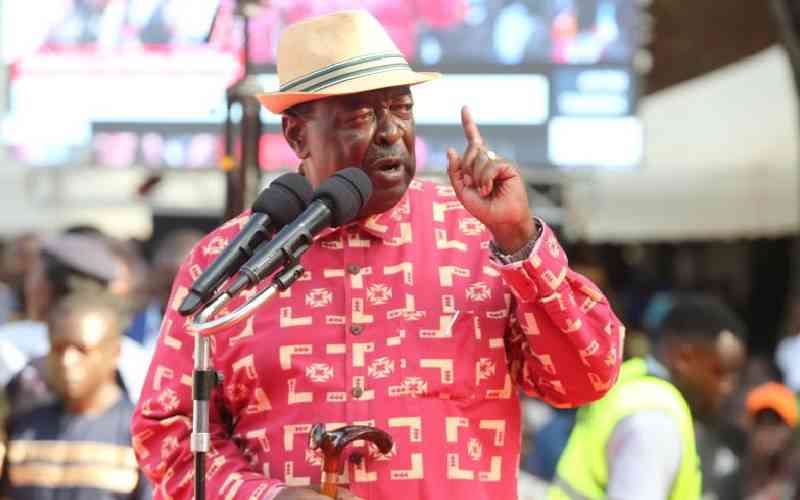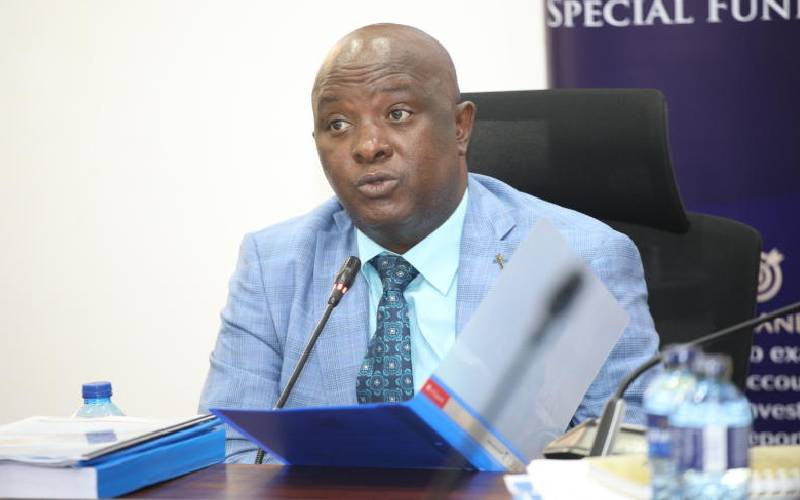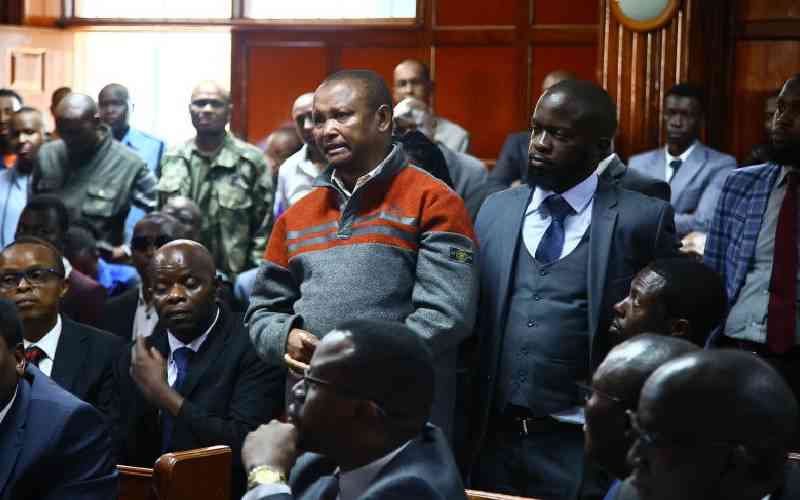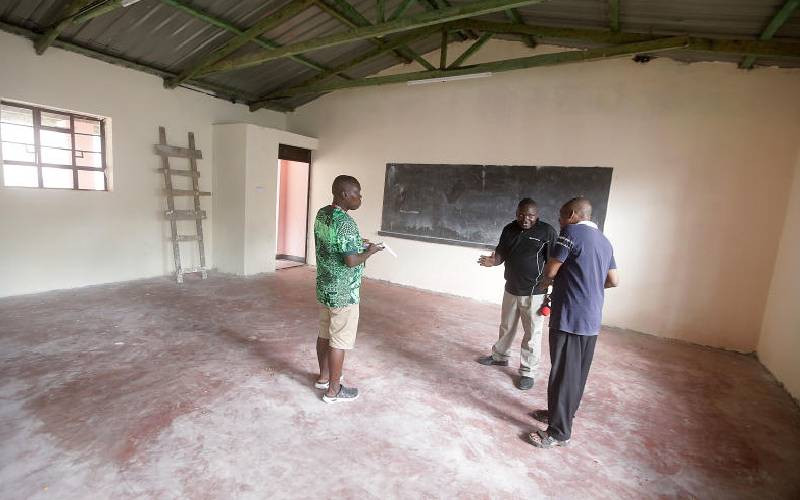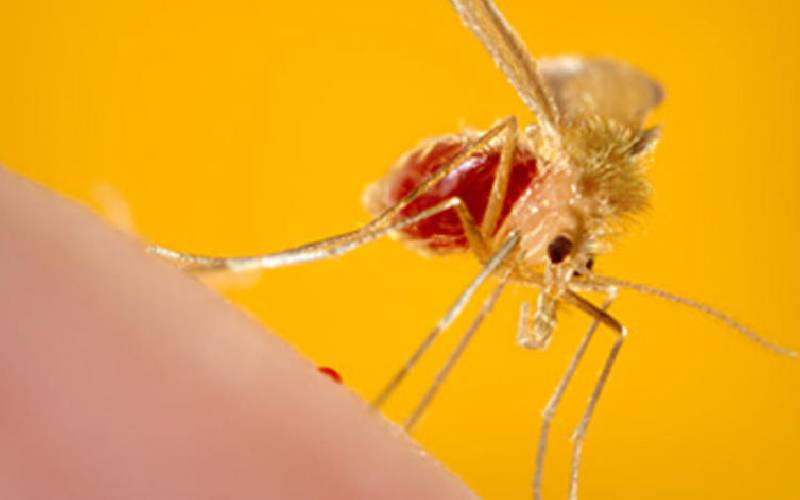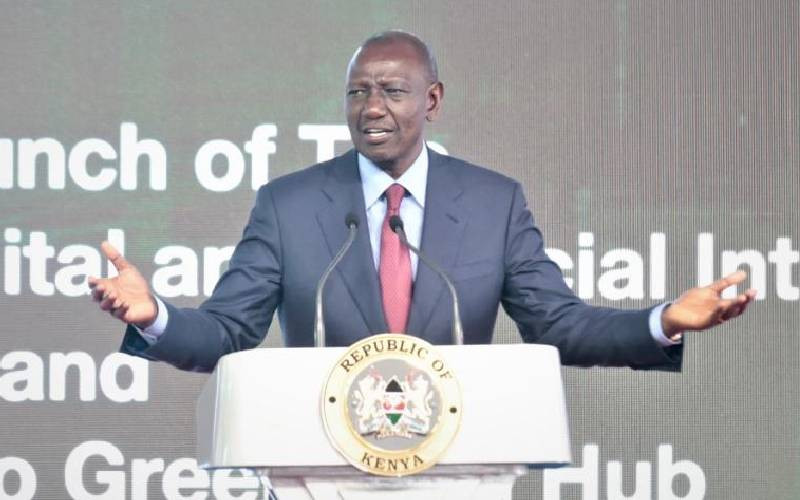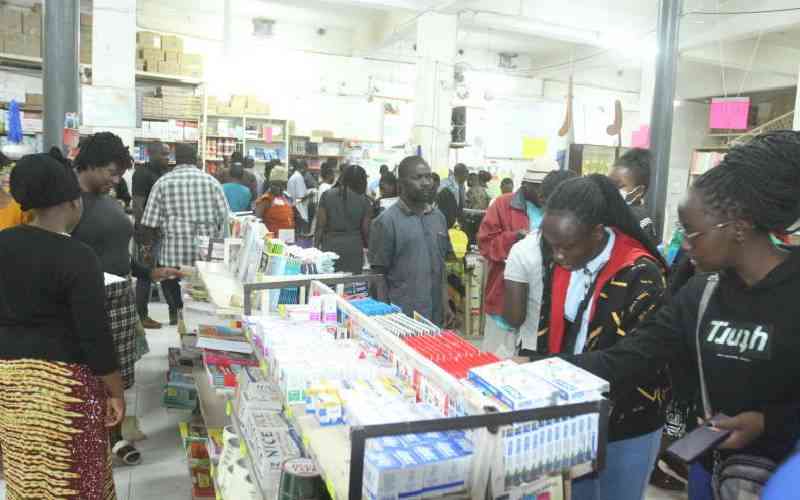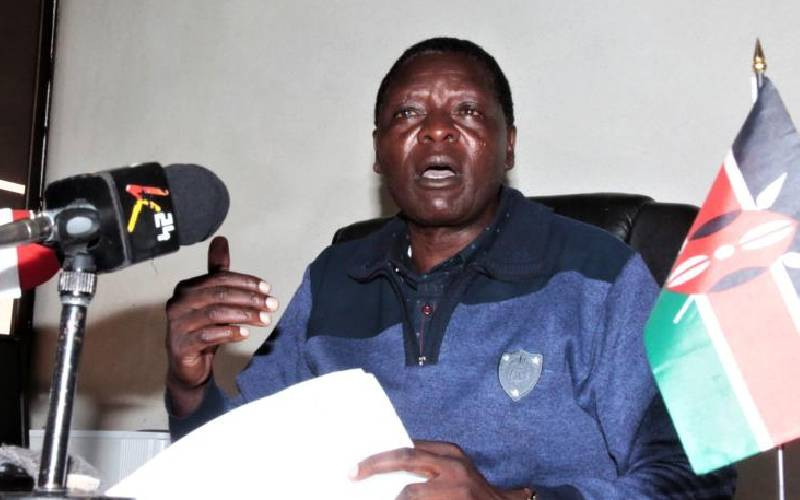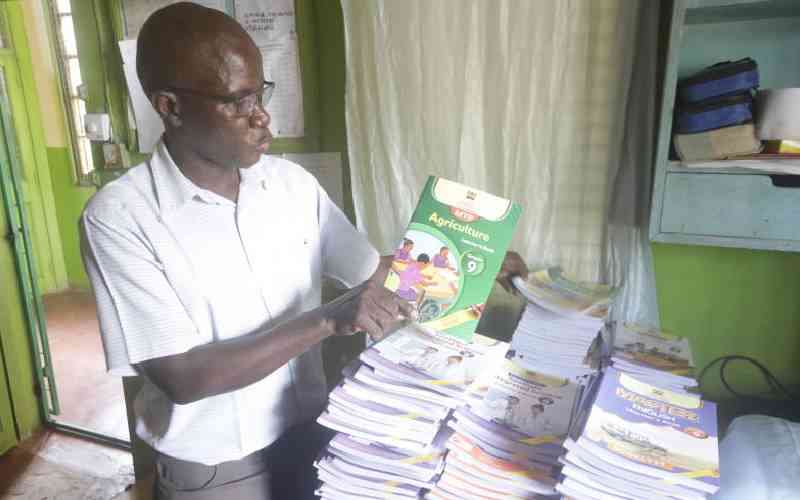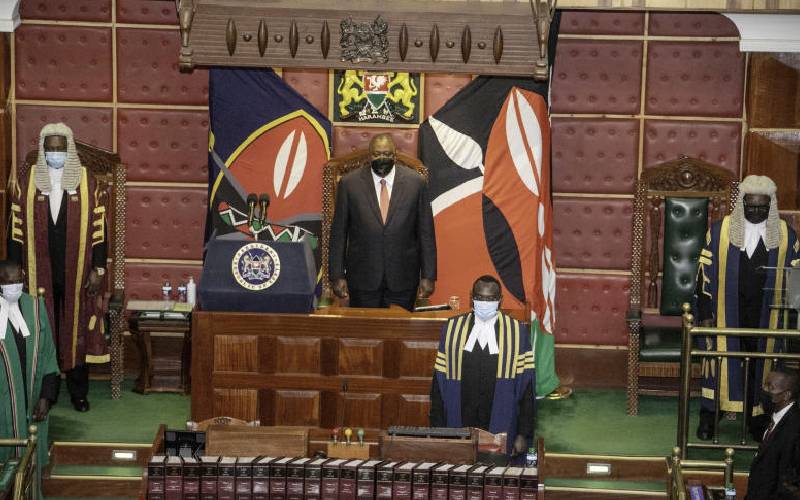
To the ruling Jubilee “Kieleweke” plus “Handshake” opposition in government, the speech was President Uhuru Kenyatta’s “best ever”. [PSCU]
The least surprising observation following President Uhuru Kenyatta’s 8th State of the Nation Address (SONA 2021) last Tuesday was that reaction was split between the pre-2022 election divide that characterises Kenya’s post-handshake politics.
To the ruling Jubilee “Kieleweke” plus “Handshake” opposition in government, the speech was Uhuru’s “best ever”. For the ruling Jubilee “Tangatanga” side not quite in government, the address had more craters than the Great Rift Valley.
That the One Kenya Alliance principals have kept radio silence merely confirms the middling “kati-kati” dilemma they currently face.
The divide in judgment wasn’t restricted to the politicians. Expert opinion on the speech was equally divided.
For some, Uhuru provided a comprehensive summation of his work since 2013. After all, this period will be historically remembered as the Uhuru, not Jubilee, administration that has followed the Jomo, Moi and Kibaki administrations. For others, the address was full of “happy clappy” good news but completely blinded to the reality of everyday Kenya. The unanswered question here is how Kenyans would have reacted to a speech sprinkled with bad news. Sometimes, spin works.
Spare a thought for the everyday Kenyan. Regardless of the official occasion, the demand remains the same. How does the leadership propose to practically, not rhetorically, address the lived issues of the day–unemployment, high cost of living, general insecurity, police brutality, daily bribery, and government service of “madharau”?
Take any opinion poll over the past decade and a half. These are the five issues that keep Kenyans awake at night; that lead Kenyans to conclude, often by a polling super-majority, that the country is headed in the wrong direction.
Excluding the corporate part of private sector that is often silent on national matters, it is fair to conclude that SONA 2021 was, as the old beauty joke goes, “nice from far, but far from nice”. This is to miss the point. This column argues that SONA 2021 presents, in its good and bad, an important baseline for the future. Let us briefly describe the canvas on which this baseline is sketched and painted.
Outside of national disasters and emergencies, the President has four political opportunities to address Kenyans every year; Madaraka Day to commemorate Kenya’s internal self-governance, Mashujaa Day to celebrate our national heroes, Jamhuri Day to memorialise the independent Kenyan republic, and SONA.
While the first three of these addresses are expected to build on the themes by which they are titled, the latter is more narrowly prescribed in the Constitution. To be clear, SONA is an accountability statement to Kenyans on the state of our Article 10 national values and principles, international obligations under Article 2(5), and national security under Article 240. More of this later.
Two observations are immediately apparent. The first is that leadership addresses outside these four moments are generally about bad (disasters and emergencies) and very rarely about good news. When was the last time, in any Kenyan presidency since independence, that Kenyans were treated to a positive national address that truly captured the public imagination?
Colonial legacy
As stated in a previous column, this is the design result of a State built to prevent bad through law rather than promote good through policy. It reflects the colonial legacy of the administrative, not political, State–a State designed to “manage African bad” in the interests of private good. The picture today is same administrative forest, different monkeys.
Which leads us to the second observation. Modern national addresses, particularly since 2003, have tended to paper over the broad themes of the moment–internal self-governance, heroes, republican independence, before engaging in a dry litany of “development achievements”. The difference in the post-Moi era between the Kibaki and Uhuru speeches is the former tended towards socio-economics (say, increased agricultural production) while the latter’s preference is for the tasks government has completed.
The reality is that these are “Head of Government” not “Head of State” speeches. Kibaki’s were about country, then government; Uhuru’s about government, then country. Neither truly spoke or speaks to the nation as the occasion demands. The downward-facing trend-line between these two leaders is best captured by a famous tweet a few years ago to the effect that “Kenya is not a country, it is a business”.
The Constitution prescribed specific content for SONA in order to strengthen the narrative around the nation, not the country or government. It recognised that SONA was the ultimate national address about “who and where we are” not “what we do, did or have done”. It implicitly assumed leaders would find communication spaces, including the Budget Speech, to celebrate government’s ordinary work outputs. These are the spaces in which to report progress against our Vision 2030 and Big Four super-plans.
Using this canvas, SONA 2021 offers a baseline for the future around three notions–what Uhuru actually said, what he was expected to say and didn’t, and what the Constitution commands him to speak to.
Readers have already seen the highlights reel. Consistent with the “feel good” nature of the address, and building on four national questions which emerged during his Madaraka Day address in June, Uhuru sang the praises of economic acceleration (question one) through extensive infrastructure investment (roads, rail, ports, electric power) as well as fiscal allocations towards devolution. He used the idea of futuristic “big push” investments (question two) to support ports expansion and the growing military presence in civilian activity.
He spoke to the ways in which the dignity of the people (question three) has been addressed through water, health, housing, food security, education and national security.
Most significantly, Uhuru made political stabilisation (question four) the most important question, emphasising its urgency, and setting this out as the foundation for “greater justice, fairness, health, wealth and security”.
There are three baselines for the future from what Uhuru said. The first, once data-verified, is to treat these as the starting point, or building block for Kenya’s future. The second, subtler one is to translate these government deliverables into citizen-centric baselines. Infrastructure and facilities are only as useful to Kenyans as they are usable, which brings us back to acceptability, accessibility and affordability. Third, what does a growing military presence in public service provision mean for civilian public service?
A big part of the negative take on SONA centred on what was not covered but was expected to have been. The flip side of massive infrastructure investment is the debt mountain. That Treasury itself this week warned that the stock of public debt is dangerously close to matching, if not surpassing, annual economic output (GDP) is pause for serious thought. Corruption was the other area that received short shrift. That it no longer pervades official speeches as it used to in the past suggests that it is now accepted as a developmental “gremlin” and workarounds (read, military above) are more convenient than real fixes.
There is, of course, the citizen perspective alluded to earlier. Remember the five things that keep Kenyans awake at night. It is difficult to speak to the lived experience if one has not lived the experience.
Yet the baseline from what was not said harks back to the law vs policy question mentioned above. Where is actionable policy for good that Kenyans deserve, before the enforceable law against our bad?
What Uhuru did or did not say centres around the respective “developmental achievements” and “lived experiences” for leaders addressing the led. To be clear, they are about the government, an agent of the State in which the people are supposed to reside as one nation. SONA is about the nation. It is an accountability statement by the leadership to the nation, not a progress report.
Good governance
So the real messages we were supposed to get from the address should have answered three “what do we look like as a nation today?” questions. First, on the Article 10 values and principles that underpin our democracy, undergird our humanity, enforce good governance and build our sustainable future. These are our foundations; the Constitution is simply the roof over our collective heads.
Second, on the Article 2 international commitments that are automatically adopted as part of our monist legal order. Basically, what have we committed to, and what does this mean for the everyday Kenyan?
Third, the state of our security. The address contained the correct language around “freedom from want” and “freedom from fear”, but what does this look like in daily lives seeking human security in its full manifestation–food, health, environmental, economic, political, personal and community security? What is the state of the top-down protection and bottom-up pillars that define our human security?
The President was fully within his rights in delivering the SONA that he did, and it is not the intention of this column to change private preferences, although Kenya deserves more Head of State and less Head of Government in these national addresses. The broader reflection that SONA 2021 points us to is the sort of baseline that leaders of 2022 and beyond may wish to contemplate even as campaign promises are liberally dished out to the public. We will tease out thoughts about what this means in the next column.
Kabaara is a public policy expert and management consultant
 The Standard Group Plc is a multi-media organization with investments in media platforms spanning newspaper print
operations, television, radio broadcasting, digital and online services. The Standard Group is recognized as a
leading multi-media house in Kenya with a key influence in matters of national and international interest.
The Standard Group Plc is a multi-media organization with investments in media platforms spanning newspaper print
operations, television, radio broadcasting, digital and online services. The Standard Group is recognized as a
leading multi-media house in Kenya with a key influence in matters of national and international interest.

